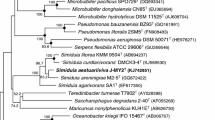Abstract
A Gram-negative, aerobic, non-motile, dark brown-coloured and rod-shaped bacterial strain, designated G-MB1T, was isolated from a tidal flat sediment of the South Sea, South Korea. Strain G-MB1T was found to grow optimally at 25 °C, at pH 7.0–8.0 and in the presence of 2.0 % (w/v) NaCl. A neighbour-joining phylogenetic tree based on 16S rRNA gene sequences revealed that strain G-MB1T fell within the clade comprising Thalassomonas species, clustering with the type strains of Thalassomonas agarivorans, Thalassomonas loyana, Thalassomonas ganghwensis and Thalassomonas agariperforans, with which it exhibited 16S rRNA gene sequence similarity values of 96.0–96.9 %. The 16S rRNA gene sequence similarity values between strain G-MB1T and the type strains of the other Thalassomonas species were 94.6–95.1 %. Strain G-MB1T was found to contain Q-8 as the predominant ubiquinone and C16:0, C17:1 ω8c, C16:1 ω9c, C12:0 3-OH and summed feature 3 (C16:1 ω7c and/or C16:1 ω6c) as the major fatty acids. The major polar lipids of strain G-MB1T were phosphatidylglycerol, phosphatidylethanolamine and one unidentified aminolipid. The DNA G+C content of strain G-MB1T was determined to be 42.4 mol%. Differential phenotypic properties, together with the phylogenetic distinctiveness, revealed that strain G-MB1T is separated from other Thalassomonas species. On the basis of the data presented, strain G-MB1T is considered to represent a novel species of the genus Thalassomonas, for which the name Thalassomonas fusca sp. nov. is proposed. The type strain is G-MB1T (=KCTC 32499T = NBRC 109830T).

Similar content being viewed by others
References
Bowman JP, McMeekin TA (2005) Order X. Alteromonadales ord. nov. In Brenner DJ, Krieg NR, Staley JT, Garrity GM (eds) Bergey’s manual of systematic bacteriology, 2nd edn, vol. 2, part B. Springer, New York, p 443
Hosoya S, Adachi K, Kasai H (2009) Thalassomonas actiniarum sp. nov. and Thalassomonas haliotis sp. nov., isolated from marine animals. Int J Syst Evol Microbiol 59:686–690
Jean WD, Shieh WY, Liu TY (2006) Thalassomonas agarivorans sp. nov., a marine agarolytic bacterium isolated from shallow coastal water of An-Ping Harbour, Taiwan, and emended description of the genus Thalassomonas. Int J Syst Evol Microbiol 56:1245–1250
Komagata K, Suzuki KI (1987) Lipid and cell wall analysis in bacterial systematics. Methods Microbiol 19:161–207
Leifson E (1963) Determination of carbohydrate metabolism of marine bacteria. J Bacteriol 85:1183–1184
Macián MC, Ludwig W, Schleifer KH, Garay E, Pujalte MJ (2001) Thalassomonas viridans gen. nov., sp. nov., a novel marine γ-proteobacterium. Int J Syst Evol Microbiol 51:1283–1289
Minnikin DE, Patel PV, Alshamaony L, Goodfellow M (1977) Polar lipid composition in the classification of Nocardia and related bacteria. Int J Syst Bacteriol 27:104–117
Minnikin DE, O’Donnell AG, Goodfellow M, Alderson G, Athalye M, Parlett JH (1984) An integrated procedure for the extraction of bacterial isoprenoid quinones and polar lipids. J Microbiol Methods 2:233–241
Park S, Choi WC, Oh TK, Yoon JH (2011) Thalassomonas agariperforans sp. nov., an agarolytic bacterium isolated from marine sand. Int J Syst Evol Microbiol 61:2573–2576
Park S, Jung YT, Yoon JH (2013) Pelagicola litorisediminis sp. nov., a novel alphaproteobacterium isolated from tidal flat sediment. Antonie Van Leeuwenhoek 104:103–110
Sasser M (1990) Identification of bacteria by gas chromatography of cellular fatty acids. MIDI technical note 101. Microbial ID, Inc., Newark
Stackebrandt E, Goebel BM (1994) Taxonomic note: a place for DNA–DNA reassociation and 16S rRNA sequence analysis in the present species definition in bacteriology. Int J Syst Bacteriol 44:846–849
Tamaoka J, Komagata K (1984) Determination of DNA base composition by reverse-phase high-performance liquid chromatography. FEMS Microbiol Lett 25:125–128
Thompson JD, Higgins DG, Gibson TJ (1994) Clustal W: improving the sensitivity of progressive multiple sequence alignment through sequence weighting, position-specific gap penalties and weight matrix choice. Nucleic Acids Res 22:4673–4680
Thompson FL, Barash Y, Sawabe T, Sharon G, Swings J, Rosenberg E (2006) Thalassomonas loyana sp. nov., a causative agent of the white plague-like disease of corals on the Eilat coral reef. Int J Syst Evol Microbiol 56:365–368
Yi H, Bae KS, Chun J (2004) Thalassomonas ganghwensis sp. nov., isolated from tidal flat sediment. Int J Syst Evol Microbiol 54:377–380
Yoon JH, Kim H, Kim SB, Kim HJ, Kim WY, Lee ST, Goodfellow M, Park YH (1996) Identification of Saccharomonospora strains by the use of genomic DNA fragments and rRNA gene probes. Int J Syst Bacteriol 46:502–505
Yoon JH, Lee ST, Park YH (1998) Inter- and intraspecific phylogenetic analysis of the genus Nocardioides and related taxa based on 16S rDNA sequences. Int J Syst Bacteriol 48:187–194
Yoon JH, Kang KH, Park YH (2003) Psychrobacter jeotgali sp. nov., isolated from jeotgal, a traditional Korean fermented seafood. Int J Syst Evol Microbiol 53:449–454
Yoon JH, Kang SJ, Lee SY (2012) Salinimonas lutimais sp. nov., a polysaccharide-degrading bacterium isolated from a tidal flat. Antonie Van Leeuwenhoek 101:803–810
Yoon JH, Lee SY, Jung YT, Lee JS, Lee KC (2013a) Litorisediminicola beolgyonensis gen. nov., sp. nov., isolated from a coastal sediment. Int J Syst Evol Microbiol 63:2025–2031
Yoon JH, Park S, Jung YT (2013b) Aestuariihabitans beolgyonensis gen. nov., sp. nov., a novel alphaproteobacterium isolated from tidal flat sediment. Antonie Van Leeuwenhoek 104:217–224
Acknowledgments
This work was supported by a grant from the National Institute of Biological Resources (NIBR) funded by the Ministry of Environment (MOE) and the Program for Collection, Management and Utilization of Biological Resources and BK21 program from the Ministry of Science, ICT & Future Planning (MSIP) of the Republic of Korea.
Author information
Authors and Affiliations
Corresponding author
Electronic supplementary material
Below is the link to the electronic supplementary material.
Rights and permissions
About this article
Cite this article
Jung, YT., Park, S. & Yoon, JH. Thalassomonas fusca sp. nov., a novel gammaproteobacterium isolated from tidal flat sediment. Antonie van Leeuwenhoek 105, 81–87 (2014). https://doi.org/10.1007/s10482-013-0055-6
Received:
Accepted:
Published:
Issue Date:
DOI: https://doi.org/10.1007/s10482-013-0055-6




